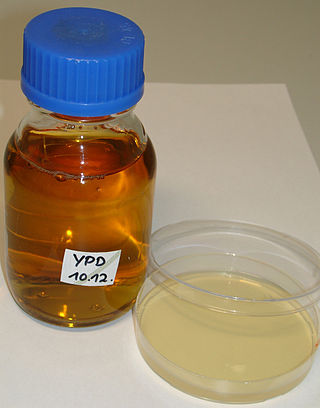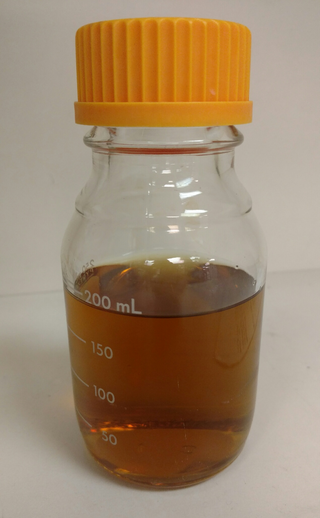Related Research Articles

An agar plate is a Petri dish that contains a growth medium solidified with agar, used to culture microorganisms. Sometimes selective compounds are added to influence growth, such as antibiotics.

A growth medium or culture medium is a solid, liquid, or semi-solid designed to support the growth of a population of microorganisms or cells via the process of cell proliferation or small plants like the moss Physcomitrella patens. Different types of media are used for growing different types of cells.

YEPD or yeast extract peptone dextrose, also often abbreviated as YPD, is a complete medium for yeast growth. It contains yeast extract, peptone, double-distilled water, and glucose (dextrose). It can be used as solid medium by including agar. The yeast extract will typically contain all the amino acids necessary for growth. By being a complete medium, YEPD cannot be used as a selection medium to test for auxotrophs. Instead, YEPD is used as a growth medium to grow yeast cultures.

Lysogeny broth (LB) is a nutritionally rich medium primarily used for the growth of bacteria. Its creator, Giuseppe Bertani, intended LB to stand for lysogeny broth, but LB has also come to colloquially mean Luria broth, Lennox broth, life broth or Luria–Bertani medium. The formula of the LB medium was published in 1951 in the first paper of Bertani on lysogeny. In this article he described the modified single-burst experiment and the isolation of the phages P1, P2, and P3. He had developed the LB medium to optimize Shigella growth and plaque formation.
Industrial fermentation is the intentional use of fermentation in manufacturing processes. In addition to the mass production of fermented foods and drinks, industrial fermentation has widespread applications in chemical industry. Commodity chemicals, such as acetic acid, citric acid, and ethanol are made by fermentation. Moreover, nearly all commercially produced industrial enzymes, such as lipase, invertase and rennet, are made by fermentation with genetically modified microbes. In some cases, production of biomass itself is the objective, as is the case for single-cell proteins, baker's yeast, and starter cultures for lactic acid bacteria used in cheesemaking.

Potato dextrose agar and potato dextrose broth are common microbiological growth media made from potato infusion and dextrose. Potato dextrose agar is the most widely used medium for growing fungi and bacteria.
Plate count agar (PCA), also called standard methods agar (SMA), is a microbiological growth medium commonly used to assess or to monitor "total" or viable bacterial growth of a sample. PCA is not a selective medium.

De Man–Rogosa–Sharpe agar, often abbreviated to MRS, is a selective culture medium designed to favour the luxuriant growth of Lactobacilli for lab study. Developed in 1960, this medium was named for its inventors, Johannes Cornelis de Man, Morrison Rogosa, and Margaret Elisabeth Sharpe. It contains sodium acetate, which suppresses the growth of many competing bacteria. This medium has a clear brown colour.

Brain heart infusion (BHI) is a growth medium for growing microorganisms. It is a nutrient-rich medium, and can therefore be used to culture a variety of fastidious organisms. In particular, it has been used to culture streptococci, pneumococci and meningococci, which can be otherwise challenging to grow. BHI is made by combining an infusion from boiled bovine or porcine heart and brain with a variety of other nutrients. BHI broth is often used in food safety, water safety, and antibiotic sensitivity tests.
Yeast extract agar is a growth medium containing yeast extract. It may refer to:
Actinoplanes italicus is distinguished by the cherry-red color of its vegetative mycelium, and by the production of soluble pigments. It is also known to produce sporangia when cultured on starch or skim milk agar. Very few strains have been found and cultured, thus A. italicus is relatively uncharacterized.
Hanseniaspora guilliermondii is a species of yeast in the family Saccharomycetaceae. In its anamorph form, it is called Kloeckera apis.
Hanseniaspora clermontiae is a species of yeast in the family Saccharomycetaceae. It was first isolated from stem rot occurring in a lobelioid plant in Hawaii, and may be endemic to the Hawaiian Islands.
Hanseniaspora lachancei is a species of yeast in the family Saccharomycetaceae. It is associated with fermenting agave juice and a tequila production facility in Mexico.
Hanseniaspora opuntiae is a species of yeast in the family Saccharomycetaceae. It has been isolated from locations worldwide, on grape berries and on prickly pear cacti.
Hanseniaspora meyeri is a species of yeast in the family Saccharomycetaceae. Samples of the species have been obtained worldwide from flowers, fruit flies, stem rot, and spoiled grape punch.
Hanseniaspora occidentalis is a species of yeast in the family Saccharomycetaceae. In its anamorph form, it was called Kloeckera javanica. It has been isolated in the wild from soil samples and vineyards. Samples of a variant have been isolated from orange juice and rotten oranges. It has demonstrated potential as an organism to reduce malic acid in wine production.
Hanseniaspora gamundiae is a species of yeast in the family Saccharomycodaceae. It has been isolated from the fruiting bodies of Cyttaria hariotii mushrooms in Patagonia and is likely responsible for the early stages of fermentation of an alcoholic chicha produced from the mushrooms.
Hanseniaspora osmophila is a species of yeast in the family Saccharomycetaceae. It is found in soil and among the bark, leaves, and fruits of plants, as well as fermented foods and beverages made from fruit.
Hanseniaspora pseudoguilliermondii is a species of yeast in the family Saccharomycetaceae. Originally isolated from orange juice concentrate, it has been found on fruit and fruit juices in locations around the world. It has also been observed forming hybrids with Hanseniaspora opuntiae.
References
- ↑ "Xanthine Agar YM Agar • YM Broth" (PDF). Becton, Dickinson and Company. Retrieved 2008-07-13.
- ↑ Carlos Rosa, Gábor Péter (2005-11-18). Biodiversity and Ecophysiology of Yeasts: The Yeast Handbook. ISBN 9783540261001 . Retrieved 2008-07-13.
- ↑ "Yeast and Malt Extract with Glucose Agar Recipe". LabRat. theLabRat.com. 2005. Retrieved 23 February 2018.